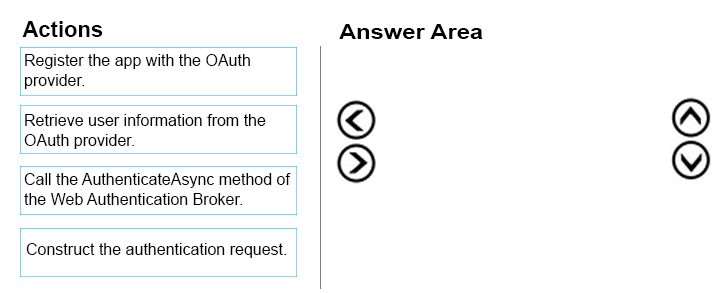DRAG DROP
You are developing a Universal Windows Platform (UWP) app.
The app has the following requirements:
Users must be able to authenticate with the app by using a third-party OAuth provider.
User must have the option of using Single Sign-On.
You obtain the security identifier (SID) for the app from the Windows Dev Center.
You need to implement authentication for the app.
In which order should you perform the actions? To answer, move all actions from the list of actions to the answer area and arrange them in the correct order.
Select and Place:

Explanation:
Step 1: Register your app with your online provider
You must register your app with the online identity provider to which you want to connect. You can find out how to register your app from the identity provider. After registering, the online provider typically gives you an Id or secret key for your app.
Step 2: Build the authentication request URI
The request URI consists of the address where you send the authentication request to your online providerappended with other required information, such as an app ID or secret, a redirect URI where the user is sent after completing authentication, and the expected response type. You can find out from your provider what parameters are required.Step 3-4: Connect to the online provider
You call the AuthenticateAsync method to connect to the online identity provider and get an access token. The method takes the URI constructed in the previous step as the requestUri parameter, and a URI to which you want the user to be redirected as the callbackUri parameter.
Note: Step 5: Connecting with single sign-on (SSO).
By default, Web authentication broker does not allow cookies to persist. Because of this, even if the app user indicates that they want to stay logged in (for example, by selecting a check box in the provider’s login dialog), they will have to login each time they want to access resources for that provider. To login with SSO, your online identity provider must have enabled SSO for Web authentication broker, and your app must call the overload of AuthenticateAsync that does not take a callbackUri parameter. This will allow persisted cookies to be stored by the web authentication broker, so that future authentication calls by the same app will not require repeated sign-in by the user (the user is effectively “logged in” until the access token expires).
https://docs.microsoft.com/en-us/windows/uwp/security/web-authentication-broker



The answer is wrong. Here is the msdn explanation: https://docs.microsoft.com/en-us/windows/uwp/security/web-authentication-broker
1. Register your app with your online provider
2. Build the authentication request URI
3. Connect to the online provider using call from broker
4. And retrieve data
So, the correct is 1 4 3 2
18
0